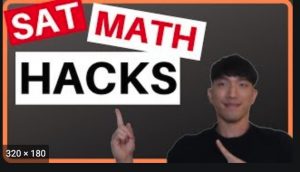 If you’ve taken any SAT Prep courses in the past, you are probably already aware that you have to prepare for the SAT Math portion. The SAT is a test that tests not only your math skills but also your reading and writing skills. As such, the preparation for the SAT Math portion can be very helpful in making sure you do well on this test. The most important thing to keep in mind is that while there are some advanced strategies for taking the SAT, the most important strategy is to practice your skills on a regular basis. Here, I will share with you some tips for preparing for the SAT Math section.
If you’ve taken any SAT Prep courses in the past, you are probably already aware that you have to prepare for the SAT Math portion. The SAT is a test that tests not only your math skills but also your reading and writing skills. As such, the preparation for the SAT Math portion can be very helpful in making sure you do well on this test. The most important thing to keep in mind is that while there are some advanced strategies for taking the SAT, the most important strategy is to practice your skills on a regular basis. Here, I will share with you some tips for preparing for the SAT Math section.
The first tip I have for you on how to get an 800 on the math section is to make sure you do not leave anything out on the test. The math portion of the SAT can be lengthy and tedious, and it is very easy to miss things and to review things that were not particularly challenging in the previous sections of the SAT. The math portion of the SAT is divided into three sections, and it is very easy to see what is going on before you know the order of the sections. The three sections include: Critical Reasoning, Multiplying, and Calculus. You need to work hard throughout the entire test to ensure that you cover each one thoroughly.
The second tip I have for you on how to get an 800 on the SAT Math is to practice as much as possible. The best way to prepare for math is to actually take math classes that you want to take, so if you don’t want to take algebra or trigonometry, then you need to practice as much as possible. There are many different prep software programs, as well as tutorials available at local libraries and on the Internet. When you make a practice test, you will be surprised at just how difficult some topics are.
The third tip comes from the previous tip. It is also about preparation, and that is getting a calculator. A calculator is extremely useful when you go to the SAT testing site, because you can plug in your answer to see if you are correctly answering the question, rather than having to guess. You will also be able to see your calculations in black and white. You may even find yourself using your calculator in class, which is highly recommended because you will see just how well you are doing.
The fourth tip includes the use of multi-step problems and graphing calculators. These are tools that many students do not have, and if you take the time to learn them, they will really help you prepare for the math questions that you will be faced with during the SAT exam. These tools include: graphing calculators, trigraphs, and calculator cards. The purpose of this step is to familiarize you with the different calculators that are available on the SAT.
The fifth tip addresses inequalities in the math section that may be present on the SAT exam. In particular, it discusses the idea of “inferences”. This includes the idea that an answer that seems “reasonable” in one way may not necessarily be so in another way. The idea is that the logical explanation of a given set of facts is inherently suspect as far as being true, because the real world contains many exceptions. In short, these “reputable” math methods may not always be accurate.
Finally, the sixth tip addresses some algebra problems that will be encountered during the SAT math section. The first thing to do is to look at your entire hand, so that you will have a full understanding of your graphing, coordinate, and quadratic equations. Next, you should look at your calculator, so that you will be able to identify any incorrect shapes or measurements. Finally, you should make sure that you are solving equations using only the operation that you know is correct. For example, instead of solving for x before working out the tangent of a quadratic equation, work out the equation first using only x, then solve for the tangent. In order to ensure that you get correct answers, try to memorize your solutions instead of rechecking them after you have them.
These six tips are designed to help you prepare for SAT math, specifically the multi-step SAT math section. The best way to prepare for these tests is to practice as much as possible. Try not to spend too much time on any one problem; instead, spend enough time to complete as many problems as possible in a short amount of time. Additionally, learn how to manage your time and work hard when you do solve problems. By following these tips, you will do well on your SAT math and enjoy a higher grade.